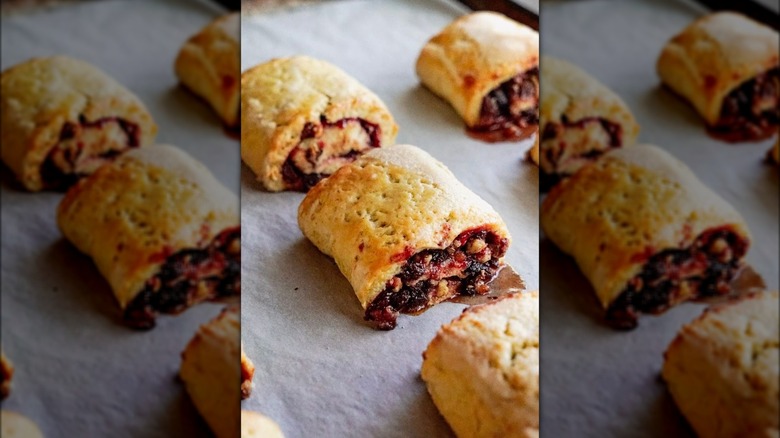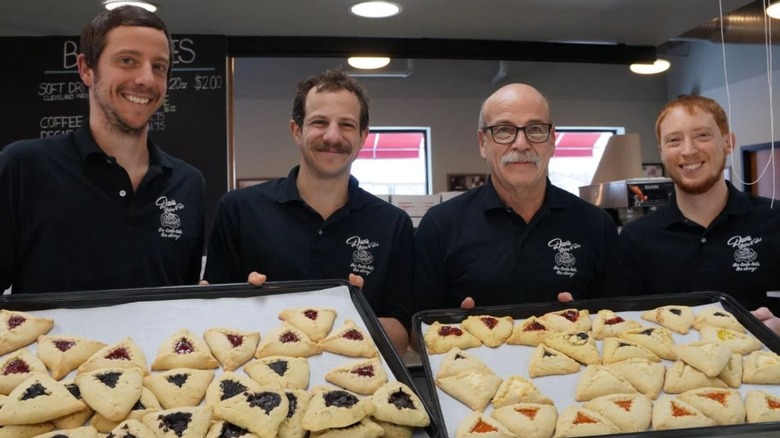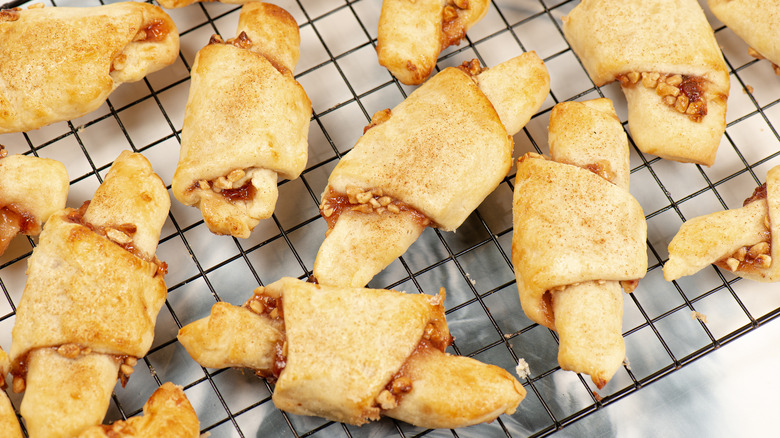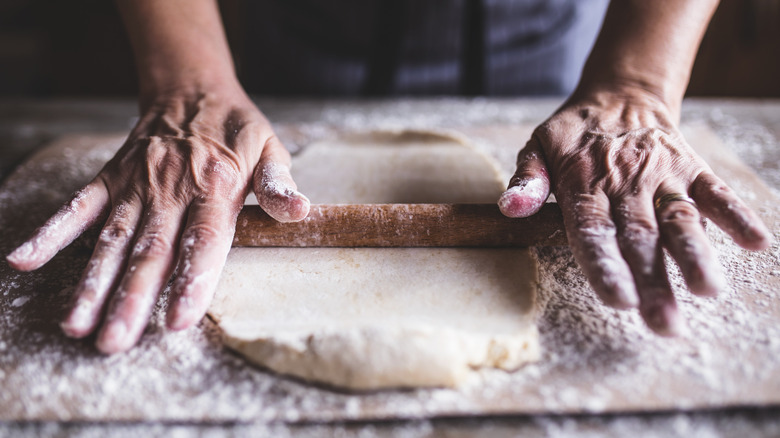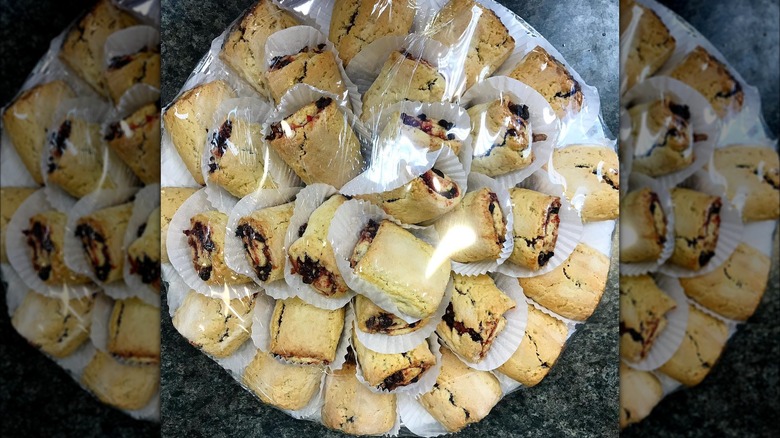What Is A Russian Tea Biscuit And Where You Can Buy Them In Cleveland
Have you ever eaten a rugelach and thought, "These should be bigger"? If so, you might want to get to Cleveland, home of the Russian tea biscuit. Though Russian tea biscuits differ from rugelach in several ways, their shape and filling options are pretty similar. For those who cannot get enough of the American-style rugelach, made using a shortcrust and plenty of filling, Russian tea biscuits are guaranteed to win over your heart and tastebuds.
I grew up within the Jewish community of Cleveland and have eaten my fair share of Russian tea biscuits (and rugelach). It wasn't until I left the city that I became aware they were as ubiquitous to the area as calling the grassy land between the sidewalk and the street a "tree lawn".
While Russian tea biscuits may be one of Cleveland's best-kept secrets when it comes to local foods, anyone traveling to the area would be wise to eat like a Clevelander and seek out this unique, delicious pastry. I interviewed third generation Davis Bakery owner Jay Davis, as well as chef Jeremy Umansky over at Larder Bakery & Delicatessen, to get the scoop on this Cleveland baked good, and where you can get your hands on one.
What is a Russian tea biscuit?
Russian tea biscuits are a pastry sold, served, and largely associated with Cleveland's Jewish community. However, they are consumed by many Clevelanders, regardless of religious or cultural associations. Alongside local foods like Ballpark mustard, Great Lakes Beer, and coconut bars, Russian tea biscuits have become a familiar local treat, adding to the Ohio city's culinary fabric, made up of cuisines and flavors from across the globe.
These unique-yet-familiar pastries have cultural roots in the Ashkenazi Jewish communities that immigrated to Cleveland. Shaped like American-style rugelach, Russian tea biscuits are made from a shortcrust dough, which is rolled out, slathered with filling — often raspberry jam, nuts, raisins, and a good sprinkle of cinnamon — and then rolled up like a Swiss roll and cut into individual slices before baking.
The result is a flaky, sometimes crumbly pastry with a scone-like texture and a jammy, sweet center. It's a pastry that can justifiably be eaten at any time of day, as a breakfast treat, an after-dinner dessert, or somewhere in between. Their size is comparable to other full-sized danishes, with a shape and taste that resembles its little sister, the rugelach.
Where do Russian tea biscuits come from?
In the early 1900s, Jewish communities in Cleveland and subsequent Jewish bakeries saw substantial growth as waves of Jewish immigrants moved to the area. Sherwin's Bakery was opened in 1920 by Abraham Cherwinsky, who emigrated in 1891 from Grajewo, Poland. Sherwin's Bakery remarkably remained open throughout the Great Depression and World War II — during the former, it was reported to have sold Russian tea biscuits at the cost of three pastries for five cents. Though there is no conclusive evidence on record, Sherwin's may have been the first bakery to make this product.
Meanwhile, the founders of Davis Bakery (which was established in 1939), Ben, Julius, and Carl Davis, created their family recipe for Russian tea biscuits through their varied experiences working at local bakeries and sharing recipes while serving in the Navy. The brothers' recipe uniquely reflected the city, the era, and Jewish dietary traditions by not using lard, and it is still used today, now a signature item of the bakery itself.
Inherently tied to Cleveland's large Eastern European Jewish communities and food businesses, you can also find Russian tea biscuits in other bakeries and delis around the city.
What makes them different than the Jewish American-style rugelach?
Rugelach are known for their diminutive size. Even their name, which means "little twists" in Yiddish, refers to their petit nature. Originally from Eastern Europe, rugelach eventually made its way to the U.S. As a result of the Great Depression and both World Wars, a yeasted, laminated pastry was altered. Bakers and companies removed the yeast to lower labor costs and the amount of time it took for the dough to rise. Eventually, they added cream cheese to increase the caloric value and help to make up for rationing and malnutrition following periods of scarcity.
Though it depends on the bakery and the recipe, some Russian tea biscuits, such as those hand-made by Davis Bakery, do not use butter or cream cheese in the dough. This, along with the size, distinguishes Russian tea biscuits from rugelach. There are also two different ways to roll out rugelach; the first is to roll the dough into logs, much like a Swiss roll, and then cut the dough to create individual snail-like twists. The alternative way is to roll each pastry individually, forming it into a more crescent moon-like shape. Russian tea biscuits, meanwhile, are rolled out into logs and then cut into individually sized pieces.
While many Jewish bakeries in Cleveland, like Davis Bakery and Larder, sell both Russian tea biscuits and rugelach, make sure you know which one you're ordering at the counter.
How do you make Russian tea biscuits?
Making Russian tea biscuits requires dedication, time, and patience. According to Davis Bakery's Jay Davis, the process cannot be rushed. "We make our Russian tea biscuit dough in a batch of 200 lbs. at a time. All the ingredients are added into the bowl, and it is a very short mix — [approximately] one to three minutes," he says, adding of the next steps, "It is rolled by hand into a large chunk of dough. The dough then rests for 24 hours in refrigeration." Then, it "needs to sit out at room temperature for 30 minutes, immediately prior to rolling it out with a pin," Davis explains.
Once all 200 lbs. of dough is rolled out, and separated into 20-lbs. batches, fillings are added. At Davis Bakery, this includes a traditional raspberry filling along with raisins, walnuts, and cinnamon sugar, while other available fillings include apricot, poppy seed, and chocolate. The dough is then meticulously rolled by hand, like a jelly roll, Swiss roll, or rugelach, before being cut into the perfect size. Each piece is brushed with an egg wash and sprinkled with granulated sugar before baking. It's undoubtedly a labor of love; a nod to the history of the bakery and the city itself.
Meanwhile, Jeremy Umansky of Larder Bakery & Delicatessen (established in 2018) tells us that pastry chef Allie La Valle-Umansky seeks out Ukranian cream cheese from a local importer to use in her Russian tea biscuits, which draw upon flavors from Czarist cuisine and have featured flavors from sweet tea to wild berries.
Where can you buy them?
Sadly, over the last decade, some of the once-institutions of Cleveland's Jewish bakery and deli scene have closed their doors for good, like Corky and Lenny's, which made the heartbreaking announcement of its closure in December 2023. The good news, however, is that Russian tea biscuits aren't going away anytime soon. There are now a mix of old-school and new-school bakeries and establishments that carry the Cleveland staple. Institutions like Davis Bakery, Jack's Deli, and The Stone Oven Bakery, alongside relative newer-comers Goldie's Donuts & Bakery and Larder Bakery & Delicatessen, are happy to ply you with as many Russian tea biscuits as your heart desires (that is, until they sell out).
Jay Davis says it's remained one of the bakery's signature pastries. Davis Bakery continually sells around 1500 Russian tea biscuits each week — the dough often lovingly hand-made by Stuart Davis, with a few selected baking vets hand rolling each one.
Like other pastry and cookie offerings, Russian tea biscuits can be purchased as an individual treat or presented on trays with several other pastry varieties for bigger gatherings and events both within and outside of Cleveland's Jewish community.

